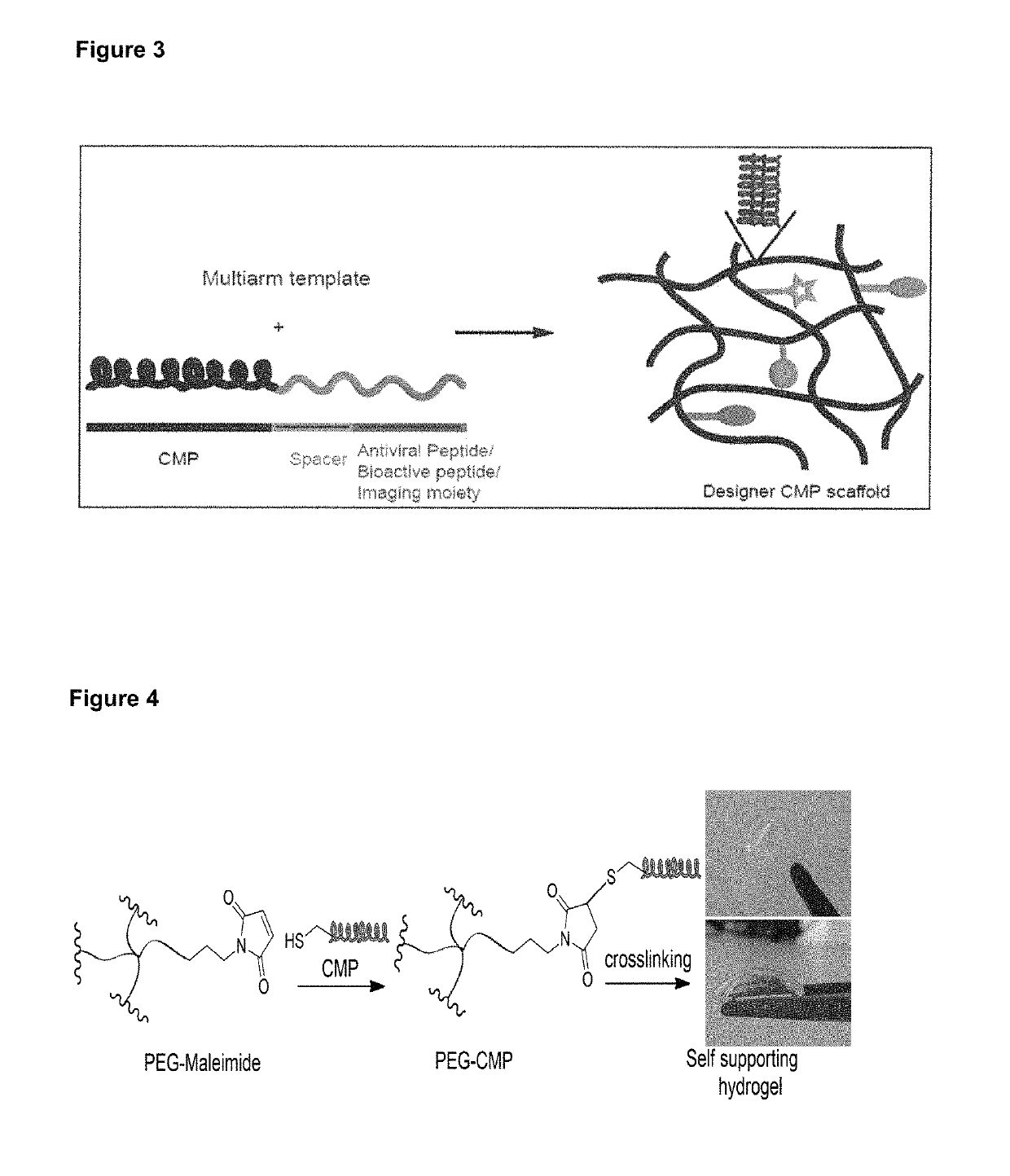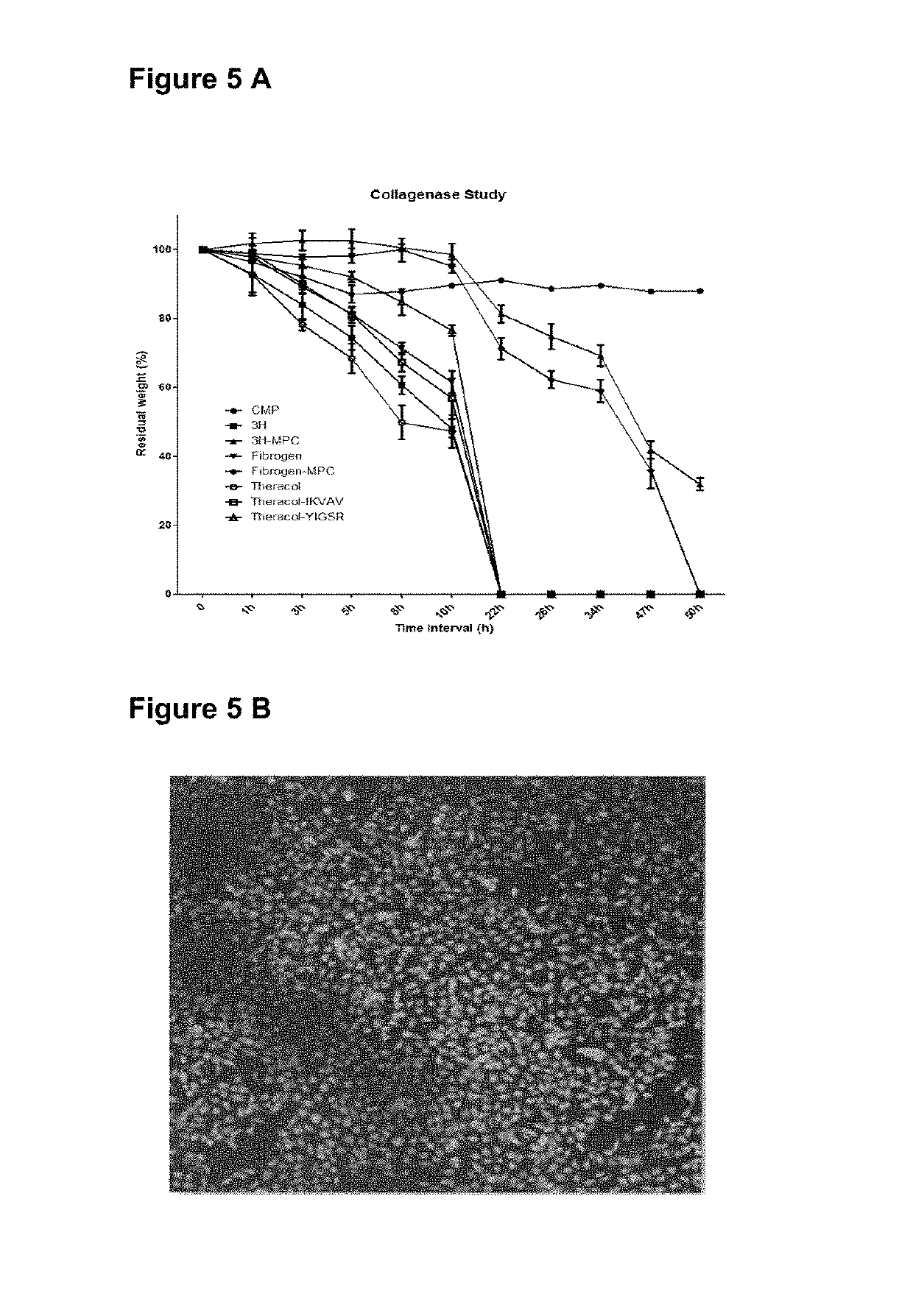Collagen mimetic peptide
a collagen and mimetic peptide technology, applied in the field of collagen mimetic peptides, can solve the problems of physical damage to the eye, lack of donor organs worldwide, and current supplies cannot meet the demand, and achieve the effect of facilitating healing
- Summary
- Abstract
- Description
- Claims
- Application Information
AI Technical Summary
Benefits of technology
Problems solved by technology
Method used
Image
Examples
example 2
[0201]Hydrogels comprising the CMP are stable in the presence of collagenase. As shown in FIG. 5A) the residual weight of the CMP comprising hydrogel is reduced by approximately 10% in the presence of collagenase whereas hydrogels comprising collagen or recombinant human collagen (3H, 3H-MPC, Fibrinogen, Fibrinogen-MPC, Theracol, Theracol-IKVAV or Theracol-YIGSR) show significant digestion after 22 h or 50 h respectively. CMP comprising hydrogels are highly biocompatible and support cell adhesion and growth. FIG. 5B shows coverage by corneal epithelial cells in vitro. The ability to support cell adhesion and growth is retained even after exposure to enzyme.
[0202]CMP-PEG hydrogels when examined under high pressure freezing transmission electron microscopy, showed fibril-like structures (FIG. 14A) similar to their RHC counterparts comprising full-length collagen fibrils (FIG. 14B).
example 3
[0203]Cell growth on the core material such as MPC-MMA one week after seeding is poor preventing cell and vessel ingrowth and allowing unhindered light transmission. Hydrogels comprising collagen-MPC and grown for one week show cell overgrowth similar to cells cultured for one week in tissue culture plates (FIG. 7).
[0204]CLP-PEG hydrogels supported growth of human corneal epithelial cells in culture without any cytotoxic effects, showing in vitro biocompatibility (data not shown). Subsequent subcutaneous implantation of the hydrogels into rats for 90 days confirmed biocompatibility (FIG. 14F) and hydrogel stability in vivo.
example 4
[0205]The CMP-comprising hydrogels can be easily patterned such as a for example a biotin-terminated pattern using photolithography or imprinting (FIG. 8). The patterned surfaces enable cell growth and / or adhesion. FIG. 9 shows fluorescence microscopy of images obtained from the surface of RHCIII-MPC hydrogels patterned with 30 μm (FIG. 9A) and 200 μm stripes (FIG. 9C) visualized by staining with an anti-fibronectin antibody [in red]. The corresponding images show corneal epithelial cells growing along the fibronectin stripes. These cells were exposed to a live-dead stain and are mainly green with only 1-2 red cells, showing that majority of cells are viable on the patterned stripes (FIG. 9B and FIG. 9D).
PUM
| Property | Measurement | Unit |
|---|---|---|
| transparent | aaaaa | aaaaa |
| weight % | aaaaa | aaaaa |
| elastic modulus | aaaaa | aaaaa |
Abstract
Description
Claims
Application Information
 Login to View More
Login to View More - R&D
- Intellectual Property
- Life Sciences
- Materials
- Tech Scout
- Unparalleled Data Quality
- Higher Quality Content
- 60% Fewer Hallucinations
Browse by: Latest US Patents, China's latest patents, Technical Efficacy Thesaurus, Application Domain, Technology Topic, Popular Technical Reports.
© 2025 PatSnap. All rights reserved.Legal|Privacy policy|Modern Slavery Act Transparency Statement|Sitemap|About US| Contact US: help@patsnap.com



